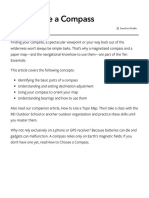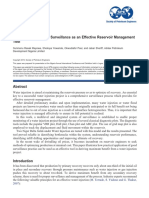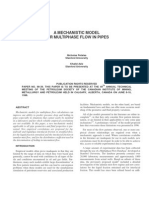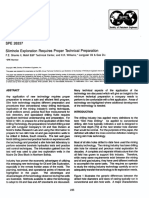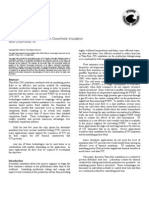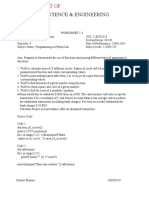SPE 118173 Using A Dynamic Coupled Well-Reservoir Simulator To Optimize Production of A Horizontal Well in A Thin Oil Rim
SPE 118173 Using A Dynamic Coupled Well-Reservoir Simulator To Optimize Production of A Horizontal Well in A Thin Oil Rim
Uploaded by
Davide BoreanezeCopyright:
Available Formats
SPE 118173 Using A Dynamic Coupled Well-Reservoir Simulator To Optimize Production of A Horizontal Well in A Thin Oil Rim
SPE 118173 Using A Dynamic Coupled Well-Reservoir Simulator To Optimize Production of A Horizontal Well in A Thin Oil Rim
Uploaded by
Davide BoreanezeOriginal Title
Copyright
Available Formats
Share this document
Did you find this document useful?
Is this content inappropriate?
Copyright:
Available Formats
SPE 118173 Using A Dynamic Coupled Well-Reservoir Simulator To Optimize Production of A Horizontal Well in A Thin Oil Rim
SPE 118173 Using A Dynamic Coupled Well-Reservoir Simulator To Optimize Production of A Horizontal Well in A Thin Oil Rim
Uploaded by
Davide BoreanezeCopyright:
Available Formats
SPE 118173
Using a Dynamic Coupled Well-Reservoir Simulator to Optimize Production
of a Horizontal Well in a Thin Oil Rim
E.D. Nennie, SPE, G.J.N. Alberts, SPE, and E. Peters, TNO, The Netherlands, and E. van Donkelaar, Shell
International Exploration and Production
Copyright 2008, Society of Petroleum Engineers
This paper was prepared for presentation at the 2008 Abu Dhabi International Petroleum Exhibition and Conference held in Abu Dhabi, UAE, 36 November 2008.
This paper was selected for presentation by an SPE program committee following review of information contained in an abstract submitted by the author(s). Contents of the paper have not been
reviewed by the Society of Petroleum Engineers and are subject to correction by the author(s). The material does not necessarily reflect any position of the Society of Petroleum Engineers, its
officers, or members. Electronic reproduction, distribution, or storage of any part of this paper without the written consent of the Society of Petroleum Engineers is prohibited. Permission to
reproduce in print is restricted to an abstract of not more than 300 words; illustrations may not be copied. The abstract must contain conspicuous acknowledgment of SPE copyright.
Abstract
Stabilization and optimization of production are the key challenges for smart well control. In order to compare the
effectiveness of different control strategies, a simulation environment can be used. To study and control the effects of for
instance slugging, gas coning and wax deposition, both reservoir dynamics and the dynamics of multi-phase well flow have to
be taken into account in such a simulation environment. In this paper we use a dynamic coupled well-reservoir simulator to
identify instabilities of a field case and test a control strategy to mitigate gas coning and wax deposition.
The dynamic simulation environment has been developed within the research framework of the 'Integrated System
Approach Petroleum Production' knowledge center of TNO, TU Delft and Shell. This simulator has been validated with field
data of a horizontal well located in a thin oil rim, suffering from gas coning and containing a crude which has a high tendency
to wax. With the help of the simulation environment it was possible to understand the production instabilities observed in this
well and to determine a control strategy to stabilize and optimize its production. The results of the coupled well-reservoir
simulations are presented and the phenomena that are most likely to cause the production instabilities observed in the field are
identified.
In production optimization the current status is to use separate dynamic well and reservoir models. In case of significant
reservoir-well interaction this approach gives a non-realistic production forecast. This project gives a clear indication that,
when using a coupled simulation on a real field case, a better understanding of the instabilities and therefore a more accurate
production forecast and a better control strategy can be designed.
Introduction
With increasing knowledge and new technologies more complex reservoirs with respect to location and dimensions can be
explored. This brings new challenges in e.g. exploration, drilling and production. Furthermore, existing reservoirs require new
insights to be able to increase its ultimate recovery. Dedicated simulation software tools can offer these new insights by
helping to understand production instabilities and test new control strategies to avoid them and to optimize production.
The field under investigation has most of its wells drilled with long laterals in a thin oil rim, which have a strong tendency
to gas-cone. Gas coning is a phenomenon where the gas oil contact of a reservoir slowly moves towards a well as a result of oil
drawdown, see Figure 1. At a certain moment in the production life of the well the gas oil contact will reach the well and the
well will experience high influx of free gas.
A second important issue which is causing production limitations is wax deposition. Wax deposition is a known problem
for reservoirs located in cold areas or deep water, but also for reservoirs containing a crude which has a large tendency to wax.
Wax precipitates from the crude when the temperature of the crude drops below the critical wax solubility temperature. The
crude produced from the field under investigation has a maximum pour point temperature which is slightly lower than the
reservoir temperature, which implies possible wax deposition during production.
SPE 118173
Figure 1
Gas coning in a thin oil rim
These two phenomena (gas coning and wax deposition) cause some of the wells to be produced on an intermitted basis.
With a large production rate the wells suffer form large gas influx and for small production rates the wells suffer from wax
deposition. Therefore, the well is shut in and started up on a frequent basis.
Leemhuis et al. already showed that gas coning can be controlled by controlling the well head choke. A simple PID
controller was used to bean back the choke in order to keep the gas fraction at a constant level. Leemhuis et al. also found for
their test case an optimal gas fraction set point which yields a maximum in oil production (Leemhuis, 2007). In this paper the
emphasis will be on the control strategy to prevent wax deposition taking into consideration the findings of Leemhuis et al.
The coupled dynamic well-reservoir simulator, developed within the research framework of ISAPP, is used to couple the
dynamic reservoir model to the dynamic well model of one of the horizontal wells located in the field. Nennie et al. showed
that for some natural occurring and production dynamical phenomena the well dynamics are influenced by the reservoir
dynamics and visa versa. The pressure transients during gas breakthrough are much faster and closer to reality for the coupled
simulation than calculated with a stand alone reservoir model (Nennie, 2007). In this paper the coupled dynamic well-reservoir
simulator is used to test a control strategy to prevent wax deposition and simultaneously limit the gas influx.
Model Description
The reservoir is modeled in the dynamic reservoir simulator MoReS and the horizontal well is modeled in the dynamic well
simulator OLGA. The coupling between the dynamic well and reservoir models is done explicitly in Matlab. The interface
between the well and the reservoir is the natural boundary between the two. The well simulator feeds the reservoir simulator
with the computed bottom-hole pressures and the reservoir simulator feeds at the same moment in time the well simulator with
the mass flow, mass gas fraction and mass water fraction. More details about the coupling can be found in Nennie et al.
(2007).
Dynamic reservoir model
MoReS is a reservoir simulator capable of handling fractured and non-fractured reservoirs. It was designed for a wide range of
simulation applications. The reservoir model is a sector model of the complete field, given in Figure 2. Figure 2(a) shows a top
view of the reservoir with all the wells located in this sector. The highlighted well is the well of interest, which is also shown
in Figure 2(c) in more detail. Figure 2(b) gives a bottom view of the reservoir sector model.
(a)
(b)
(c)
Figure 2
(a) Reservoir top view, (b) Reservoir bottom view and (c) Reservoir detail in neighbourhood of well
SPE 118173
The reservoir model has been history matched with production data of the complete sector since it came into operation.
The history production data is given with average production over 30 days. The well highlighted in Figure 2(a) came into
operation in the end of 1996 and is located at 1090 m below sea level. Due to the thin oil rim of just 46m in height, the
reservoir has a strong tendency to gas-cone. Table 1 gives further details of the reservoir.
Table 1
Reservoir characteristics
Initial reservoir pressure
Oil density @ reservoir conditions
Oil viscosity @ reservoir conditions
Permeability (average)
Porosity
Reservoir temperature
119.3e5
775
3.5e-3
1.0e-12
0.25
43.8
Pa
kg/m3
Pa s
m2
C
Dynamic well model
OLGA is a one dimensional multi-phase flow simulator that can be used to determine the impact of well/pipe design on the
flow of oil, water and gas. It is capable of simulating transient flow behavior of the well from bottom hole to the wellhead for
all flow regimes. Including the energy equations in OLGA enables one to accurately simulate temperature profile along the
well.
a.
b.
c.
d.
e.
f.
a
Figure 3
b c d e
Production tube
Tubing
Annulus
Casing
Cement
Formation
Cross-section of the completion
The well of interest has a total along hole depth of 1910 m with a horizontal perforated part of 520 m. The inner diameter
of the production tube is 0.1 m. A cross-section of the completion is given in Figure 3. The annulus is filled with lift gas, since
the well has been equipped with a gas lift system for start-up of the well. Heat transfer parameters for the different media are
taken either from given data or average values from literature. The temperature gradient of the formation is taken as a linear
gradient with height from reservoir temperature (43.8 C) at the bottom hole to the annual average temperature (27 C). At the
top side of the vertical part of the well a swing check valve (SWC) is located with a diameter of 50 mm and a constant back
pressure of 14.7 bara.
Wax appearance
One of the problems during production is wax appearance. Of a crude at high temperature all constituents are completely
dissolved. By decreasing the temperature, at a certain temperature, wax precipitation occurs. This temperature is defined as the
critical wax solubility temperature. Wax precipitation does not necessarily lead to wax deposition, since individual wax
crystals tend to disperse in the fluid instead of depositing on a surface. If the number of wax crystals becomes large enough the
crystals may agglomerate into larger particles. These large particles then may separate out of the fluid and form solid deposits
(Lake, 2006). The solid deposits limit the flow area and are therefore unwanted. The temperature below which the crude
ceases to flow is called the pour point. To get the well bore clear of the solid deposits either the temperature has to increase
significantly to dissolve all constituents or the well has to be scraped. The approach outlined in this paper is to measure the
temperature at the well head and to control the system in such way that the temperature does not go below a prescribed value.
To get a feeling of the influence of inflow on the temperature of the crude in the well of interest, some thermal dynamical
simulations have been performed with OLGA. The well has the dimensions as described in the previous section, but for these
simulations constant inflow mass sources were used instead of the full dynamic reservoir. The mass inflow of oil, water and
gas has been varied and the temperature upstream of the valve is computed. The temperature upstream of the valve is the
minimum temperature in the well under the assumption that the formation has a linear decreasing temperature profile. The
downstream temperature of the valve is not taken into consideration under the assumption that it is more easily accessible and
therefore precautions can be foreseen to reduce the impact of wax deposition.
SPE 118173
Figure 4 shows the temperature upstream of the well head choke as a function of the oil, water and gas inflow. The
variations in the mass flows simulated are based on actual production data. On the horizontal axes are the total mass flow
(kg/s), including water, and the mass gas fraction, which is defined as the mass ratio of gas to the total mass of hydrocarbons.
The vertical axis shows the mass flow of water (kg/s).
Figure 4 Temperature upstream of the well head choke as a function of total mass inflow [kg/s], gas mass fraction
and water mass inflow [kg/s].
Important phenomena that determine the temperature in the well bore are the cooling and heating as a result of expansion,
compression, evaporation, condensation and heat exchange to the formation. As the mixture goes up in the well bore the
pressure is decreasing causing the gas and oil to expand and gas to flash out of the oil. A large amount of free gas inflow
causes a lower temperature at the well head due to the low heat capacity of the gas and the expansion of the gas. Since the heat
capacity of water is much larger than of oil and gas, a mixture containing a large amount of water will cool less and
temperatures at the well head will be higher. The travel time of the mixture determines the time the mixture has heat transfer
towards the formation. A large inflow results in a large velocity and less heat transfer to the formation. Figure 4 shows the
SPE 118173
effects on temperature of the phenomena outlined above. For large amounts of water inflow the temperatures are high and for
larger gas fractions the temperatures are low. Furthermore, the temperature increases if the total mass inflow increases.
Figure 4 forms the basis of the proposed control strategy, since with a known operation point this three dimensional graph
gives an indication of how the temperature will react on a given control action. For the well of interest the water cut is very
high, above 50%, which places the operation point in the upper region of Figure 3. The thermal contour slices show a local
minimum in temperature, which is used to develop the control strategy.
Control strategy
After a major PVT sampling campaign, representative fluid samples were taken from five different locations in the field. From
these samples the reservoir crude properties were determined, e.g. bubble point pressure, composition but also the maximum
pour point temperature. The maximum pour point temperature of the crude is 32.2 C. In order to prevent the flow from
ceasing, the temperature at the well head should be larger than this temperature.
In this paper feedback control will be used to contain the measured upstream temperature of the well head at a set point of
36 C by changing the well head choke settings. By containing the temperature at its set point the formation of solid deposits is
assumed to be prevented. For the feedback control a Proportional Integral (PI) controller has been used. This approach was
also used by Leemhuis et al., because of its simplicity and good performance (Leemhuis, 2007).
As already mentioned above, the water cut in the well of interest is very high. This places the operation point in the upper
region of Figure 4. Figure 5 gives a thermal contour slice for a mass water flow of 2.5 kg/s. This contour plot shows a local
minimum temperature. During gas breakthrough a rapid increase in gas will force the operating point towards this low
temperature region, see the red line in Figure 5. In order to contain the temperature at its set point the well head choke will be
closed and the operation point will follow the contour line of 36 C. There has to be said that Figure 5 is just illustrative.
During real production the operating point is moving though the 3D temperature field as given in Figure 4. Furthermore, by
choking the well head this 3D temperature field upstream of the well head choke is changing, due to changing pressures and
mixture velocities in the well bore.
no control
control
Figure 5
Thermal contour slice at a water flow of 2.5 kg/s
For the well of interest there has been a test session in 2002. During this test session process data has been collected at the
well head as well as down hole. This process data is used to validate our simulation model. In Figure 6(a) the contour slice of
the measurement data is given. The black circles indicate the actual measurement points and the contour is the interpolated
temperature field. Figure 6(a) is showing similar contour lines as modeled, see Figure 5. Figure 6(b) shows that the
temperatures calculated by the model are almost similar to the temperatures of measurement data. Especially the trends are
predicted correctly. The maximum difference between measurement and simulation is just 3%. The difference is expected to
be the result of the constant reservoir temperature assumption in the model. The temperature of the mixture entering the well
SPE 118173
bore is not completely constant due to the skin effect in the near well bore region. The validation of simulation model gives
confidence that the simulations results of the dynamic simulations can be used to design and test the control strategy.
(a)
(b)
Figure 6 (a) Thermal contour slice of measurement data, (b) Temperature upstream of the well head choke; OLGA
results compared to measurement data
The contour plots given in Figure 4 and Figure 5 are all steady state temperature solutions. During gas breakthrough and
control actions the temperature is changing according to inflow conditions and choke settings. This does not necessarily mean
the steady state contour lines will be followed. Therefore, the coupled dynamic simulator has to be used, which is able to
capture the dynamic effects of both the reservoir and the well.
Containing the well head temperature
To test the control strategy outlined above the well of interest is simulated from the moment free gas starts to enter the well
bore. With the gas influx pressures and temperatures in the well bore start to change. Two simulations have been performed;
one with and one without control. Figure 7 shows gas mass fraction (a), choke setting (b), upstream temperature (c) and
bottom hole pressure (d) for both simulations, where the red and black line indicate no control and control respectively.
As gas mass fraction is increasing as a result of gas breakthrough, the temperature upstream of the well head choke is
decreasing. The additional amount of gas, entering the well bore, yields additional cooling due to expansion. After ca. 38 hours
of production the gas mass fraction has increased till an amount that causes the temperature upstream of the well head choke to
cross the critical value of 36 C. From this moment in time the controller starts to contain the temperature, by closing the well
head choke. As shown in Figure 7(c) the controller is capable in containing the temperature. From ca. 60 hours since the start
of the simulation the operating point is following the contour plane of 36 C in the dynamically changing 3D temperature field
as given in Figure 4. For the uncontrolled simulation the temperature will continuously decrease and eventually the well will
need pigging or scraping.
Besides the benefit of containing the temperature to a certain value so that wax deposition is prevented, a second benefit is
that the increase of gas mass fraction (gas breakthrough) is dampened. A large influx of gas is unwanted for three reasons.
Firstly, and most important for this field, large influx of gas can not be facilitated by the topside equipment. Secondly, the gas
phase may start dominate the production. Thirdly, fast depletion of op the gas cap will take away the driving energy. An
uncontrolled well will, after some time, need periodic pigging and scraping and will be terminated earlier in time in order to let
the gas oil contact to move away from the well.
Looking at the individual mass flows of the different phases (oil, gas and water) in Figure 8, the conclusion could be that
due to choking of the well head choke the oil flow is decreasing which makes the controlled well less economical attractable.
This holds for the short term until the uncontrolled well needs pigging and scraping. The controlled well remains producing
continuously during each pigging operation. Besides the loss of production during pigging you have the costs of the pigging
operation itself. Furthermore, if the controlled well can be terminated, as a result of less gas influx, much later than the
uncontrolled well the economical benefit is expected to be much higher.
SPE 118173
(a)
(b)
(c)
(d)
Figure 7 gas mass fraction (a), choke setting (b), upstream temperature [C] (c), and bottom hole pressure [bara] (d)
for the simulations with and without control.
12
mass flow [kg/s]
10
20
40
60
time [hours]
no control,
no control,
no control,
no control,
Figure 8
total
gas
oil
water
80
control,
control,
control,
control,
100
total
gas
oil
water
Individual mass flows of the different phases [kg/s].
SPE 118173
At the end one important note has to be made. The control strategy outlined in this paper is strongly depended on the
location of the operating point. Only for large water inflow the local minimum temperature upstream of the well head choke is
observed, see Figure 4. For wells with an operating point in the lower region of Figure 4 (less water inflow) increasing gas
influx will probably lead to much faster closure of the well head choke. Therefore, for each individual well it is important to
analyze the operating region whether this control strategy is applicable.
Conclusions
A coupled dynamic well-reservoir simulator has been used to investigate production limitations due to wax deposition and gas
coning. In order to prevent wax deposition to occur, the temperature upstream of the well head choke can be contained with
the developed control strategy. The control strategy beans back the well head choke when the temperature becomes too low. A
second benefit is that the gas influx is also contained by beaning back the well head choke. The loss of production on the short
term is expected to be compensated since less pigging operations are necessary and the well can be terminated later, if it needs
to be terminated at all, as a result of containing the free gas influx. This makes this control strategy economical attractable on
the long therm.
Future work
Several wells have been selected that produce on an intermitted basis as a result of both wax and gas coning problems. For
these wells the coupled simulator will be used to analyze control strategies, e.g. the one outlined in this paper. Since these
wells are largely suffering from gas coning, a limitation with respect to free gas influx is expected to be incorporated in the
control strategy.
This paper shows that the coupled simulation environment is a valuable tool for analyzing control strategies to mitigate gas
coning and wax deposition. In the future, the simulation environment will also be used to analyze wells with smart well control
where the inflow from different sections of the well can be controlled by inflow control valves. This enables the controller to
shut in sections with large gas influx, but also to control the inflow of water, which can be beneficial to mitigate wax
deposition. Also the simulation environment will be used to evaluate more sophisticated control strategies, such as model
predictive control.
Acknowledgment
The authors would like to thank the Shell operating unit for giving feedback and all the data required for this analysis; Stefan
Belfroid (TNO Science and Industry) and Gerard Joosten (Shell International Exploration and Production) for their feedback
and sharing their expertise; and the ISAPP knowledge centre for making this project possible.
References
Lake, L.W., J.R. Fanchi, Petroleum Engineering Handbook Volume 1: General Engineering, chapter 9 page 398-400,
Society of Petroleum Engineers, 2006
Leemhuis, A.P., S.P.C. Belfroid, G.J.N. Alberts, Gas Coning Control for Smart Wells, SPE paper 110317 presented at the
2007 SPE Annual Technical Conference and Exhibition, Anaheim, California, U.S.A., 11-14 November 2007
Nennie, E.D., G.J.N. Alberts, S.P.C. Belfroid, E. Peters, G.J.P. Joosten, An Investigation Into the Need of a Dynamic
Coupled Well-Reservoir Simulator, SPE paper 110316 presented at the 2007 SPE Annual Technical Conference and
Exhibition, Anaheim, California, U.S.A., 11-14 November 2007
You might also like
- Kneeling Chair Plans PDFDocument25 pagesKneeling Chair Plans PDFpiper1234No ratings yet
- Shell Graduate Programme e Brochure 3Document26 pagesShell Graduate Programme e Brochure 3Davide BoreanezeNo ratings yet
- How To Use A CompassDocument10 pagesHow To Use A CompassShaun JohnsonNo ratings yet
- Commutation in DC Machines PDFDocument2 pagesCommutation in DC Machines PDFTom0% (1)
- SPE 134492 Enhancing Sand Screen Reliability: An Innovative, Adaptive ApproachDocument9 pagesSPE 134492 Enhancing Sand Screen Reliability: An Innovative, Adaptive ApproachRiyaNo ratings yet
- Spe 192465 MSDocument13 pagesSpe 192465 MSPatricio EspinosaNo ratings yet
- Visualizing The MacCabe Thiele Diagram PDFDocument9 pagesVisualizing The MacCabe Thiele Diagram PDFMayank SinhaNo ratings yet
- S E SPE 1600 Extending 003 G The Ran Nge of Ga As Lift To Long Pe Rforation SDocument11 pagesS E SPE 1600 Extending 003 G The Ran Nge of Ga As Lift To Long Pe Rforation SLeo MessiNo ratings yet
- Spe 184074 MSDocument14 pagesSpe 184074 MSMilad Ebrahimi DastgerdiNo ratings yet
- SPE 110120 Geomechanics Field and Laboratory Characterization of Woodford Shale: The Next Gas PlayDocument14 pagesSPE 110120 Geomechanics Field and Laboratory Characterization of Woodford Shale: The Next Gas PlayMuhammed Al-BajriNo ratings yet
- Ecrin Petrel Plugin Guided SessionDocument21 pagesEcrin Petrel Plugin Guided SessionMarcelo Ayllón RiberaNo ratings yet
- Aspen InfoPlus.21 Mobile V7.3Document8 pagesAspen InfoPlus.21 Mobile V7.3jamestppNo ratings yet
- Sag D Piloto VenezuelaDocument11 pagesSag D Piloto VenezuelaKristian TorresNo ratings yet
- SPE 133877 Hydraulic Fracture Monitoring To Reservoir Simulation: Maximizing ValueDocument26 pagesSPE 133877 Hydraulic Fracture Monitoring To Reservoir Simulation: Maximizing ValueTrieu NguyenNo ratings yet
- Monday: - Thermodynamics of Aqueous SolutionsDocument91 pagesMonday: - Thermodynamics of Aqueous SolutionsSri Sakthi SumananNo ratings yet
- Reserved Words inDocument3 pagesReserved Words inMuneeb Khan100% (3)
- Spe 131787Document15 pagesSpe 131787downloader1983No ratings yet
- Spe 146394 MSDocument5 pagesSpe 146394 MSDr-Jitendra Vaish100% (1)
- Phreeqc 3 2013 ManualDocument519 pagesPhreeqc 3 2013 ManualpauloalpeNo ratings yet
- 04 Models - PPT (Read Only)Document32 pages04 Models - PPT (Read Only)dxdiag97No ratings yet
- SPE-178368-MS (August, 2015)Document25 pagesSPE-178368-MS (August, 2015)lulut falaNo ratings yet
- IHS Kingdom Gateway Plug in For Petrel Software BrochureDocument2 pagesIHS Kingdom Gateway Plug in For Petrel Software Brochureabhishekmoharana5412No ratings yet
- Pipe Sim 20091Document24 pagesPipe Sim 20091Yk LokeNo ratings yet
- 3D MECHANISTIC MODEL by Petalas&AzizDocument16 pages3D MECHANISTIC MODEL by Petalas&AzizKirat Purohit100% (2)
- Accurate Prediction of Compressibility by The GERG Virial EquationDocument8 pagesAccurate Prediction of Compressibility by The GERG Virial Equationxjaf01No ratings yet
- Paper SPE GeologiaDocument11 pagesPaper SPE GeologiaCAROLINA ALVARADO SANCHEZNo ratings yet
- Full Text 01Document127 pagesFull Text 01najmudeenNo ratings yet
- SPE Pando x1Document15 pagesSPE Pando x1Fernando Mostajo RocaNo ratings yet
- Effect of Paraffin Wax Deposition On The Overall Heat Transfer CoefficientDocument47 pagesEffect of Paraffin Wax Deposition On The Overall Heat Transfer CoefficientPhạm Thanh ĐạiNo ratings yet
- 2DMaps PetrelWorkflowDocument31 pages2DMaps PetrelWorkflowfritzchpNo ratings yet
- SPE 124926 PA - Diagnostico de GLDocument13 pagesSPE 124926 PA - Diagnostico de GLSamuel VmNo ratings yet
- SPE 158059 MS Screening SurfDocument11 pagesSPE 158059 MS Screening SurfAnonymous T32l1RNo ratings yet
- A Comprehensive Approach To The Design of Advanced Well Completions PDFDocument174 pagesA Comprehensive Approach To The Design of Advanced Well Completions PDFanon_450586282No ratings yet
- Spe 93594 MS PDocument5 pagesSpe 93594 MS PGustavoMillaNo ratings yet
- Spe 192741-MSDocument19 pagesSpe 192741-MSromerobernaNo ratings yet
- R y Phreeqc PDFDocument8 pagesR y Phreeqc PDFNeider BurgosNo ratings yet
- SPE 78324 Reliable Wax Predictions For Flow Assurance: Infochem Computer Services LTDDocument11 pagesSPE 78324 Reliable Wax Predictions For Flow Assurance: Infochem Computer Services LTDVinh PhamthanhNo ratings yet
- Spe 15657 MSDocument12 pagesSpe 15657 MShijoetigreNo ratings yet
- Spe 175557 MSDocument12 pagesSpe 175557 MSabdulghaffar1991No ratings yet
- Spe 180853 MSDocument18 pagesSpe 180853 MSkerron_rekhaNo ratings yet
- Spe 84497 MSDocument10 pagesSpe 84497 MSShiyeng CharmaineNo ratings yet
- Hydrogen From Carbon Containing MaterialsDocument64 pagesHydrogen From Carbon Containing MaterialsGiannis AtsoniosNo ratings yet
- Spe 96587 PDFDocument6 pagesSpe 96587 PDFMohamed YousryNo ratings yet
- Spe 168152 PaDocument11 pagesSpe 168152 PamiladNo ratings yet
- Spe 184837 MS PDFDocument18 pagesSpe 184837 MS PDFSSNo ratings yet
- Spe 10022Document17 pagesSpe 10022Jorge Carmona100% (1)
- Spe 184863 MSDocument18 pagesSpe 184863 MSSSNo ratings yet
- Opus Terra - PUNQS3Document27 pagesOpus Terra - PUNQS3Binu KaaniNo ratings yet
- OTC 15222 Management of Flow Assurance ConstraintsDocument9 pagesOTC 15222 Management of Flow Assurance ConstraintsDonna GrayNo ratings yet
- Effect of Two-Pass Trays On Distillation EfficienciesDocument7 pagesEffect of Two-Pass Trays On Distillation EfficienciesCheng ZehanNo ratings yet
- Spe 9723 PaDocument14 pagesSpe 9723 PaCarlos Carrillo VillavicencioNo ratings yet
- OTC14118 Flow Assurance Begins With Downhole InsulationDocument6 pagesOTC14118 Flow Assurance Begins With Downhole InsulationGokulnath RadhakrishnanNo ratings yet
- SPE-102079-PA Gringarten From Straight Lines To DeconvolutionDocument22 pagesSPE-102079-PA Gringarten From Straight Lines To DeconvolutionChávez Ibarra Sergio Kevin100% (1)
- Spe 59537Document14 pagesSpe 59537cmkohNo ratings yet
- ENG Petrel AveragePorosity NTG Facies Per Zone 3Q15Document7 pagesENG Petrel AveragePorosity NTG Facies Per Zone 3Q15Rodrigo BatistaNo ratings yet
- Otc 231121Document1 pageOtc 231121Uyavie ObonnaNo ratings yet
- Total G4 Well - ElginDocument18 pagesTotal G4 Well - ElginJulo DesmazuresNo ratings yet
- OTC-17355-MS - PDF Costos METANOL Vs Glicol Monoetileno PDFDocument10 pagesOTC-17355-MS - PDF Costos METANOL Vs Glicol Monoetileno PDFFélix Gallo CruzNo ratings yet
- Nodal Analysis-Based Design For Improving Gas Lift Wells ProductionDocument10 pagesNodal Analysis-Based Design For Improving Gas Lift Wells ProductionEka RamadhanNo ratings yet
- Nodal Analysis - Based Design For Improving Gas Lift Wells ProductionDocument10 pagesNodal Analysis - Based Design For Improving Gas Lift Wells ProductionSeth CheathamNo ratings yet
- Simulação de ResrvatoriosDocument8 pagesSimulação de ResrvatoriosLarissa RochaNo ratings yet
- SPE-193512-MS Evaluation of A Depleted Oil Reservoir For Gascap Blowdown Using 3D Simulation Models: A Case Study of Chrome Field DevelopmentDocument19 pagesSPE-193512-MS Evaluation of A Depleted Oil Reservoir For Gascap Blowdown Using 3D Simulation Models: A Case Study of Chrome Field DevelopmentjcbaezmNo ratings yet
- Pet 513Document19 pagesPet 513okeke ekeneNo ratings yet
- SPE 183676 Production Optimization of High Temperature Liquid Hold Up Gas WellDocument12 pagesSPE 183676 Production Optimization of High Temperature Liquid Hold Up Gas WellEdgar GonzalezNo ratings yet
- All About MudDocument91 pagesAll About MudDavide Boreaneze100% (3)
- Completions Module Question Set 1Document4 pagesCompletions Module Question Set 1Davide BoreanezeNo ratings yet
- c21462-206 CCR CHP 4-2 Well-DesignDocument13 pagesc21462-206 CCR CHP 4-2 Well-DesignJose Antonio Olvera JimenezNo ratings yet
- Tech Note Tubing LimitsDocument9 pagesTech Note Tubing LimitsViola HippieNo ratings yet
- A Practical Approach To Taxation (Personal and Business) : Contact Hours: 24 Cost (TT Dollars) : $1,850.00Document1 pageA Practical Approach To Taxation (Personal and Business) : Contact Hours: 24 Cost (TT Dollars) : $1,850.00Davide BoreanezeNo ratings yet
- Material Safety Data Sheet: Sectio N 1 - Pro Duct Informat IonDocument2 pagesMaterial Safety Data Sheet: Sectio N 1 - Pro Duct Informat IonDavide BoreanezeNo ratings yet
- BP 08172005Document8 pagesBP 08172005Davide BoreanezeNo ratings yet
- CWI Engineering CompetenceDocument33 pagesCWI Engineering CompetenceDavide BoreanezeNo ratings yet
- Leak-Off Test ProceduresDocument15 pagesLeak-Off Test ProceduresS MariusNo ratings yet
- NCSE 2006 Mathematics Paper 2Document18 pagesNCSE 2006 Mathematics Paper 2Davide BoreanezeNo ratings yet
- Course: A Practical Approach To Taxation (Personal and Business) Contact Hours: 18 Pre-Requisite: Basic Computerized Spreadsheet SkillsDocument2 pagesCourse: A Practical Approach To Taxation (Personal and Business) Contact Hours: 18 Pre-Requisite: Basic Computerized Spreadsheet SkillsDavide BoreanezeNo ratings yet
- Subaru XV E-BrochureDocument19 pagesSubaru XV E-BrochureDavide BoreanezeNo ratings yet
- Guidance Notes - 05 - Member CEngDocument14 pagesGuidance Notes - 05 - Member CEngDavide BoreanezeNo ratings yet
- Well Intervention and Productivity School: PetroDocument8 pagesWell Intervention and Productivity School: PetroDavide BoreanezeNo ratings yet
- Well Intervention and Productivity School: PetroDocument8 pagesWell Intervention and Productivity School: PetroDavide BoreanezeNo ratings yet
- Dgms Tech Circular No 2 of 2002 Accident Due To TipperDocument4 pagesDgms Tech Circular No 2 of 2002 Accident Due To Tipperj subbaraoNo ratings yet
- Guardant User ManualDocument301 pagesGuardant User Manualxprakash0% (1)
- Week 910 11 Module in Purposive CommunicationDocument8 pagesWeek 910 11 Module in Purposive CommunicationJelaiza Thea FonteNo ratings yet
- Sin TítuloDocument1 pageSin TítuloyesopunkNo ratings yet
- Face Detection Recognition Report PDFDocument7 pagesFace Detection Recognition Report PDFBushra SaleemNo ratings yet
- Crisis in Sociology: A Tired DisciplineDocument3 pagesCrisis in Sociology: A Tired DisciplinewilliamsiteNo ratings yet
- Katalog AC Fujitsu R22 PDFDocument42 pagesKatalog AC Fujitsu R22 PDFriskiriskNo ratings yet
- Ceramic TilingDocument6 pagesCeramic TilingAnonymous 3eHGEDbxNo ratings yet
- Mark IIIDocument39 pagesMark IIIapi-302506446No ratings yet
- An Integrated Control Algorithm For A Single-Stage PV Pumping System Using An Open-End Winding Induction MotorDocument10 pagesAn Integrated Control Algorithm For A Single-Stage PV Pumping System Using An Open-End Winding Induction MotorHashim KhanNo ratings yet
- Gourav 3Document4 pagesGourav 3YASH CHAUDHARYNo ratings yet
- 06 Programmable Logic Controller PracticalDocument3 pages06 Programmable Logic Controller PracticalAnkitNo ratings yet
- Basic Imaging Systems Colonydoc-ItDocument1 pageBasic Imaging Systems Colonydoc-ItNelson PerezNo ratings yet
- Michael Hall - Exceptions To PresuppositionsDocument4 pagesMichael Hall - Exceptions To PresuppositionsAyeza Umpierre100% (2)
- JavaDocument28 pagesJavaPriti ManeNo ratings yet
- Python Programming External LabDocument4 pagesPython Programming External Labbalugopalam616No ratings yet
- Conventional Encryption Message ConfidentialityDocument26 pagesConventional Encryption Message Confidentialityishita chakrabortyNo ratings yet
- 3the Living World Q & ADocument7 pages3the Living World Q & AUmapathy Harish HarishNo ratings yet
- Lesson Plan in English 7 Date: Phase Teacher'S Activity Annotation I. Objectives II. Learning TasksDocument5 pagesLesson Plan in English 7 Date: Phase Teacher'S Activity Annotation I. Objectives II. Learning TasksAngel MijaresNo ratings yet
- Lxmldoc-2 3Document439 pagesLxmldoc-2 3Angelo SilvaNo ratings yet
- Modul Bahasa Inggris Perguruan TinggiDocument25 pagesModul Bahasa Inggris Perguruan TinggiSri Mulyani BNo ratings yet
- International BusinessDocument42 pagesInternational BusinessyoshinokurukoNo ratings yet
- Project 2 Mpu2202u4 Cocurriculum Nov Ss 2021Document11 pagesProject 2 Mpu2202u4 Cocurriculum Nov Ss 2021Amsyar MustaqimNo ratings yet
- 5 Scale Analysis of External Natural ConvectionDocument56 pages5 Scale Analysis of External Natural Convectionmahimachauhan6767No ratings yet
- Environmental Assessment of The Hot-Dip Galvanization ProcessesDocument3 pagesEnvironmental Assessment of The Hot-Dip Galvanization ProcessesArshath FleminNo ratings yet
- CONTRINEX Sensor CatalogDocument174 pagesCONTRINEX Sensor CatalogMemik TylnNo ratings yet
- Jeffrey A. Mello 4e - Chapter 3 - Strategic ManagementDocument29 pagesJeffrey A. Mello 4e - Chapter 3 - Strategic ManagementHuman Resource Management75% (4)


